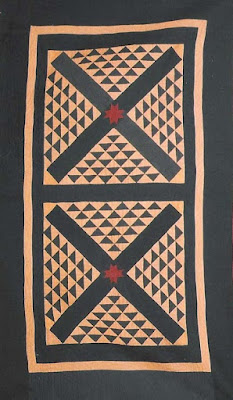Here's a great Ohio invention:
The Railroad Crossing quilt
A small community of Amish quiltmakers who lived in Holmes County at the end of the 19th
century started piecing their solid color scraps into triangles.
Holstein Collection at International Quilt
Study Center & Museum
2003.003.0285
And pieced those into bigger triangles.
About 1920, Holmes County, Ohio
Date inscribed 1921 L.J.H.
A star, some sashing---
a masterpiece.
Darwin says NOT faded.
The earliest I have seen the pattern and the name published was in Quilters Newsletter in 1977.
I saw it as an octagonal block fit into a square and gave it a number in the octagonal blocks,
BlockBase #299.4
Here's a variation with a pinwheel in the center. Same magazine
but a square block. #2932.
1928, Christina Yoder Schlaabach
Perhaps this is the one I indexed.
Now in the Faith & Stephen Brown collection.
Or maybe this one. Both the pinwheels have been in Darwin Bearley's inventory.
Darwin still has a shop in Akron.
He says he still owns all of these and they are pictured in his book
Antique Ohio Amish Quilts. He also says:
"I've always thought this pattern was developed by the Ohio Amish as I never saw another one that wasn't Ohio Amish."
He is the authority.
The story I have heard is antique dealer Sandra Mitchell (1942-2000), who lived in Columbus, Ohio, found the quilts in Amish families in the 1970s just as the market for Amish quilts was getting hot. Holmes County has one of the highest per-capita populations of Amish in the U.S. with families going back there for generations.
But Darwin says Sandra was more likely to have obtained the quilts she sold from pickers and other dealers.
A 20th-century version with a small nine patch instead of a star or pinwheel.
Signed and dated 1888 Melinda Miller
This one has a simple nine patch in the center of the block.
It's also in the Brown collection, the earliest date-inscribed
Amish quilt they have.
Small nine patches where the blocks meet in the center line.
Another from the Brown collection. No extra
patchwork blocks in the square---but a lot of triangles.
I count 44 in each of the larger triangles.
Most stitchers made do with fewer HSTs.
1914 Anna Hershberger,
from Darwin Bearley's inventory
International Quilt Museum
The story I have heard is antique dealer Sandra Mitchell (1942-2000), who lived in Columbus, Ohio, found the quilts in Amish families in the 1970s just as the market for Amish quilts was getting hot. Holmes County has one of the highest per-capita populations of Amish in the U.S. with families going back there for generations.
But Darwin says Sandra was more likely to have obtained the quilts she sold from pickers and other dealers.
Holmes County
Sandra and Darwin sold many of those pictured here to collectors.
We assume the name Railroad Crossing was used by the families who inherited these quilts.
Here's a version of the basic block. It's not in BlockBase.
Mainstream quilters made it too...
from the prints popular in the 1880-1925 period.
From the Virginia project and their book Quilts of Virginia.
These "English" quilts are pretty much the same pattern.
But I haven't found a published source.
An extra row of triangles...Maybe once red and green?
If you were going to make one you'd probably want to cut and piece your triangles like this so you have a straight edge along the straight edge.
You don't want to have to corral your edges like Anna did in 1914.
72 x 95"
I figured out a 20-inch block in EQ8.
3-inch sashing between the blocks
Diagonals cut 3-3/8" wide
by 12".
Cutting would be smarter starting with 5" squares instead of 5-1/4". How big would the block be? See what happens.



























































